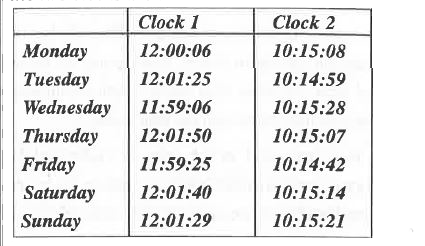राष्ट्रीय प्रयोगशाला में स्थित एक मानक घड़ी से तुलना करके दो घड़ियों की जाँच की जा रही है | मानक घड़ी जब दोपहर के 12 : 00 : 00 का समय दर्शाती है, तो इन दो घड़ियों के पाठ्यांक इस प्रकार हैं-
घड़ी 1घड़ी 2सोमवार12:00:0510:15:06मंगलवार12:01:1510:14:59बुधवार11:59:0810:15:18बृहस्पतिवार12:01:5010:15:07शुक्रवार11:59:1510:14:53शनिवार12:01:3010:15:24रविवार12:01:1910:15:11
यदि आप कोई ऐसा प्रयोग कर रहे हो जिसके लिए आपको परिशुद्ध समय अंतराल मापन की आवश्यकता है, तो इनमें से आप किस घड़ी को वरीयता देंगे ? क्यों
दिए गए प्रेक्षणों से यह स्पष्ट होता हैं कि सात दिनों में घड़ी 1 के प्रेक्षणों में अंतर का परिसर 162 सेकण्ड है जबकि घड़ी 2 के प्रेक्षणों में अंतर का परिसर 31 सेकण्ड है | जिसमे घड़ी 1 के पाठ्यांक, घड़ी 2 के पाठ्यांक की तुलना में मानक समय के अधिक निकट है | यहाँ महत्वपूर्ण तथ्य यह है कि शून्यांक त्रुटि की तुलना में समय में होने वाला परिवर्तन अधिक महत्व रखता है क्योंकि शून्यांकी त्रुटि को तो कभी भी सरलता से दूर किया जा सकता है | इस प्रकार घड़ी 1 की तुलना में घड़ी 2 को वरीयता दी जाएगी |
Topper's Solved these Questions
- BOOK - SCIENCE PUBLICATIONCHAPTER - मात्रक एवं मापन EXERCISE - TEST YOU KNOWLEDGE7videos
मात्रक एवं मापन
- BOOK - SCIENCE PUBLICATIONCHAPTER - मात्रक एवं मापन EXERCISE - MCQs8videos
मात्रक एवं मापन
- BOOK - SCIENCE PUBLICATIONCHAPTER - महत्वपूर्ण भौतिकीय व गणितीय सूत्र EXERCISE - उदाहरण12videos
महत्वपूर्ण भौतिकीय व गणितीय सूत्र
- BOOK - SCIENCE PUBLICATIONCHAPTER - समतल में गति EXERCISE - अन्य महत्त्वपूर्ण प्रश्न (आंकिक प्रश्न)29videos
समतल में गति
Similar Questions
पूरक मात्रकों के नाम लिखिए |
02:50View Solutionकिसी कण द्वारा तय दूरी x तथा समय t में निम्न संबंध है- x=At+Bt2 इसमें A व B की विमायें हैं-
06:35View Solutionपृथ्वी की सतह से h ऊँचाई पर गुरुत्वीय त्वरण g का मान दिया जाता है -
gh=g(1+hR)2 जिसमे g पृथ्वी सतह पर गुरुत्वीय त्वरण है। द्विपद सिद्धान्त का प्रयोग करके h<<R के लिए g के मान का व्यंग्य प्राप्त कीजिए।View Solutionदो बल 5 व 10 न्यूटन परस्पर 120∘ का कोण बनाते हुए स्थित है। उनके परिणामी बल का परिमाण व दिशा ज्ञात कीजिए।
02:10View SolutionDraw the temperature-time graph in each of the following cases: Time (in hours:), 7:00, 9:00, 11:00, 13:00, 15:00, 17:00, 19:00, 21:00 Temperature 0F) ∈ , 100, 101, 104, 102, 100, 99, 100, 98 (ii) Time (in hours), 8:00, 10:00, 12:00, 14:00, 16:00, 18:00, 20: Temperature ( 0F) in, 100, 101, 104, 103, 99, 98, 100
04:12View SolutionTwo clocks are being tested against a standard clock located in a national laboratory. At 12:00:00 noon by the standard clock, the readings of the two clocks are :
Clock 1Clock 2Monday12:00:0510:15:06Tuesday12:01:1510:14:59Wednesday11:59:0810:15:18Thursday12:01:5010:15:07Friday11:59:1510:14:53Saturday12:01:3010:15:24Sunday12:01:1910:15:11
If you are doing an experiment that requires precision time interval measurements, which of the two clocks will you prefer ?06:11View Solutionराष्ट्रीय प्रयोगशाला में स्थित एक मानक घडी से तुलना करके दो घड़ियों की जांच की जा रही है। मानक घडी जब दोपहर के 12:00:00 का समय दर्शाती है , तो इन दो घड़ियों के पाठ्यांक इस प्रकार हैं :
घडी 1 घडी 2
सोमवार 12:00:05 10:15:06
मंगलवार 12:01:15 10:14:59
बुधवार 11:59:08 10:15:18
बृहस्पतिवार 12:01:50 10:15:07
शुक्रवार 11:59:15 10:14:53
शनिवार 12:01:30 10:15:24
रविवार 12:01:19 10:15:11
यदि आप कोई ऐसा प्रयोग कर रहे हो जिसके लिए आपको परिशुद्ध समय अंतराल मापन की आवश्यकता है, तो इनमें से आप किस घडी को वरीयता देंगे ? क्यों ?03:55View Solutionयदि शब्द PROBABILITY के अक्षर एक पंक्ति में यदृच्छया लिखे जाते है तो दो के साथ आने की प्रायिकता है -
03:55View Solutionपरवलय y=x2−2x+5 की जीवा दो बिन्दुओं जिनकी कोटि है, x1=1,x2=3 को जोड़ती है, तो इस जीवा के है, को जोड़ती है , तो इस जीवा के समान्तर परवलर की स्पर्श रेखा का समीकरण होगा
03:15View SolutionTwo clocks are being tested against a standard clock located in a national laboratory. At 12:00:00 noon by the standard clock , the readings of the two clocks are :

If you are doing an experiment that requires 'precision time interval' measurements, which of the two clocks will you prefer? c03:16View SolutionTwo clocks are being tested against a standard clock located in a national laboratory. At 12:00:00 noon by the standard clock, the readings of the two clocks are : {:(,"Clock1", "Clock 2"),("Monday",12:00:05:,10:15:06),("Tuesday",12:01:15,10:14:18),("Wednesday",11:59:08,10:15:18),("Thursday",12:01:50,10:15:07),("Friday",11:59:15,10:14:53),("Saturday",12:01:30,10:15:24),("Sunday",12:01:19,10:15:11), ("Sunday",12:01:19,10:15:11):} If you are doing an experiment that requires precision time interval measurements, which of the two clocks will you prefer? The range of variation in time of clock ?
03:00View SolutionTwo clocks are being tested against a standard clock located in a national laboratory. At 12:00:00 noon by the standard clock, the readings of the two clocks are :
Clock1Clock 2Monday12:00:05:10:15:06Tuesday12:01:1510:14:18Wednesday11:59:0810:15:18Thursday12:01:5010:15:07Friday11:59:1510:14:53Saturday12:01:3010:15:24Sunday12:01:1910:15:11Sunday12:01:1910:15:11
If you are doing an experiment that requires precision time interval measurements, which of the two clocks will you prefer? The range of variation in time of clock ?06:21View SolutionTwo clocks are being tested against a standard clock located in a national laboratory At 12 : 00 : 00 noon by standard clock, the readins of the two clocks are
DayClock - IClock - IIMonday12:00:0510:15:06Tuesday12:01:1510:14:59Wednesday11:59:0810:15:18Thursday12:01:5010:15:07Thursday12:01:5010:15:07Friday11:59:1510:14:53Saturday12:01:3010:15:24Sunday12:01:1910:15:11
From the Observations carefully read the following conclusive statements.
Statement I : Zero - error in clock II is much longer than zero - error in clock I.
Statement II : Zero - error can always be corrected by applying necessary corrective measures
Statement III : Precision of clock - I is more than precision of clock - II
Statement IV : Precision of clock - II is more than precision of clock - I
Pick up the correction option from the following.View SolutionDraw the temperature-time graph in each of the following cases: Time (in hours:), 7:00, 9:00, 11:00, 13:00, 15:00, 17:00, 19:00, 21:00 Temperature 0F) ∈ , 100, 101, 104, 102, 100, 99, 100, 98 (ii) Time (in hours), 8:00, 10:00, 12:00, 14:00, 16:00, 18:00, 20: Temperature ( 0F) in, 100, 101, 104, 103, 99, 98, 100
View Solutionदो अंको की एक संख्या में इकाई स्थान का अंक दहाई स्थान के अंक से 3 अधिक है यदि दोनों अंकों का जोड़ 11 हो तो संख्या निकालिए।
View Solution

